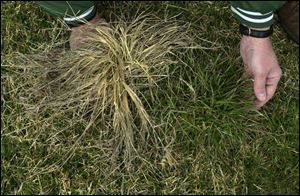
Spring is time to conquer crabgrass
3/23/2005Early spring is the best time to protect lawns from crabgrass.
Two types of the annual grassy weed threaten turf: Large crabgrass (Digitaria sanguinalis) has densely hairy leaves and sheaths, and smooth crabgrass (Digitaria ischaemum) is less hairy and has purplish stems.
Crabgrass grows low to the ground and has a few upright stems, making it resemble a crab. It sprouts quickly, produces seeds all summer, and can spread like wildfire.
Crabgrass turns brown and dies at the first sign of frost, but if it gets a foothold in a lawn during the growing season, homeowners may need to repair big patches of turf every spring.
Goosegrass, yellow foxtail, and annual bluegrass are other annual grassy weeds. If these or crabgrass pop up in a lawn, the turf may be under stress. Maybe the lawn has some bald spots from bad drainage, compaction, or scalping from a lawn mower.

Crabgrass is an annual grassy weed that thrives in summer and turns brown and dies at the first sign of frost. Above, a browned crabgrass skeleton from the previous summer.
Many weeds are more tolerant of wet and compacted soils than grass cultivars. To help the turf, don't mow the grass too short, and keep it properly watered and fertilized. A good crop of healthy, tough, vigorous turf will choke out many weed problems.
If a lawn has weed problems despite proper turf care, sprinkle the yard with a pre-emergent herbicide.
Crabgrass seeds start to germinate when soil temperatures reach 55 to 60 degrees for seven to 10 days in a row. This is part of their survival mechanism. They get a good start in a lawn before the turf revs up for the season.
Many other annual weeds start to germinate when soil temperatures are above 60 degrees.
When applying a pre-emergent herbicide, read label directions carefully, and be sure to use the chemical before the weed seeds have sprouted. Don't apply a pre-emergent herbicide if you expect other seeds or sod to grow. It will kill them as well. If you plan to plant a spring lawn, find a pre-emergent herbicide formulated for spring seeding.
Some companies combine a fertilizer and herbicide in the same bag. These products usually require the lawn to be watered after application, so the water takes the chemical into the soil to do its work on the seeds buried just beneath the surface.
If weed seeds have already sprouted, it is too late for a pre-emergent herbicide, but a post-emergent herbicide may be successful.
If you don't like using chemicals on your lawn, grab some gloves, a hoe, or other garden tool and try to remove as much of the weed root system as possible. If the area is too large, it may need to be dug up and reseeded.
Sometimes crabgrass can be a good thing. If nothing else will cover a spot with poor soil and bad drainage, a mat of crabgrass may stop soil erosion.